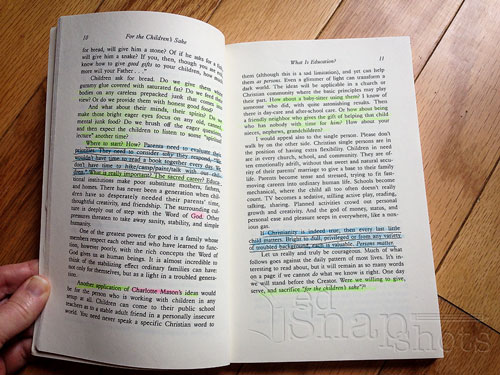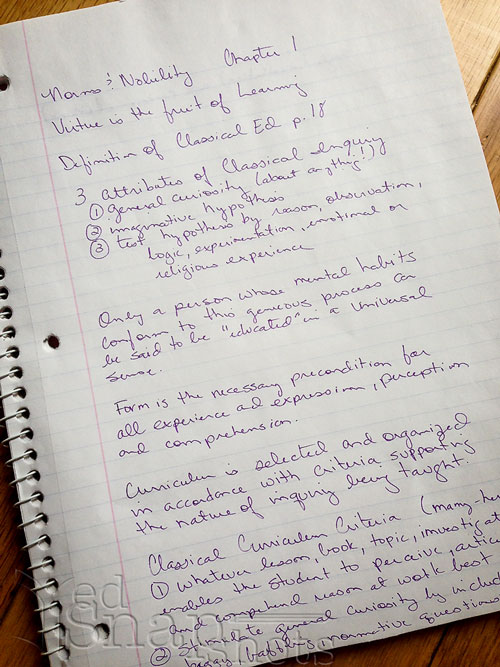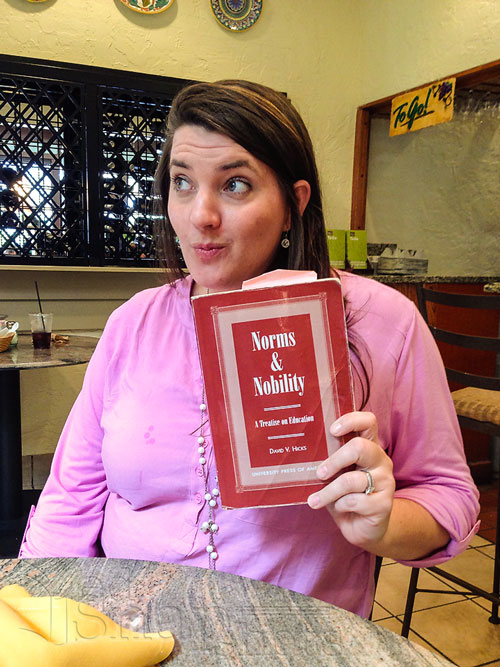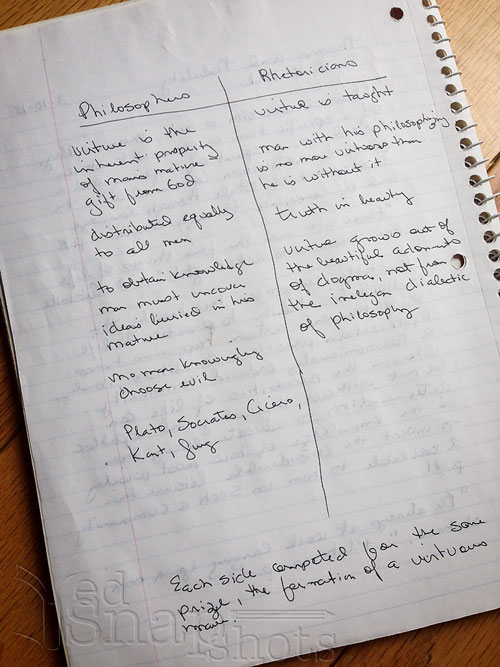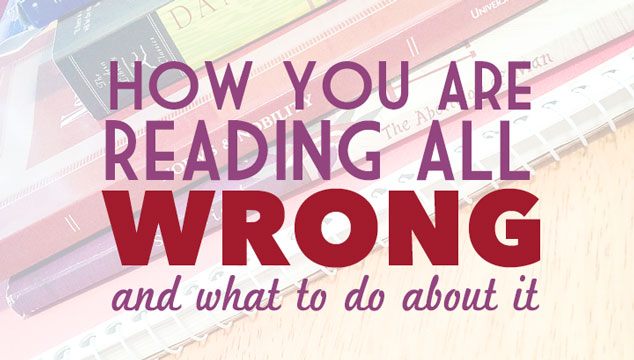
Apparently I have been reading all wrong my entire life.
The past three weeks have been a whirlwind of learning for me. A life-changing whirlwind. I went from a someone who barely had enough attention span to read a regency romance in the bathtub to this reading list:
- For the Children’s Sake
- Norms and Nobility
- The Inferno
- The Abolition of Man
- Your Questions Answered: Narration
- Up, Back and Away (Sing: One of these things is not like the other. More about this one in a minute.)
I KNOW! Crazy, right? But I am reading and enjoying all of these –feeling like I am getting tons of meaning out of them. Let me tell you how.
Sarah Mackenzie held a webinar with Andrew Kern a couple of weeks ago about commonplace books and how to deep read a book. It was fascinating, except I didn’t have a commonplace and as much as I wanted to, I didn’t feel like I could read deeply anymore.
My brain always seemed to be too tired. I was distracted. Even for my beloved book club there just didn’t seem to be enough time to get through a book in a month and be prepared to discuss it.
I read voraciously in my youth. I was an English Lit major for goodness sake — magna cum laude and all that. I should be able to do this commonplace thing. I should be able to read and to understand.
So I did what any modern day girl would do — I conducted a little virtual Q & A with my girlfriends, the Scholé Sisters. (Actually this wasn’t all my idea. The girls wanted to do the hangout and share their commonplace books. I started whining that I had no commonplace book and therefore couldn’t attend this little club meeting, when we got the brilliant idea for ME to ask all the questions that YOU would want to ask if you could be there.) And boy did I learn.
Which was all good information, but led me to an even deeper journey of reading and how to be a better reader. I started asking even more questions and doing a bit of research. Here are some things that I learned that are helping me immensely with reading now:
Read s-l-o-w-l-y.
Like a chapter a month. Or even slower. Brandy Vencel talks here about slow reading and why it is important for us and for our kids. I love the lack of pressure to finish a more difficult book and the opportunity to slow down, live with the ideas, and read and re-read them.
Susan Wise Bauer says in Stop Cleaning the Kitchen and Read a Book:
But speed is not a moral imperative. You can be informed quickly, and you can collect facts quickly, but to be enlightened is to understand an idea (like justice or charity or freedom) and use it to make sense of the facts that you’ve gathered. That is a slow process. No matter how quickly you read, enlightenment takes time, and you have to make peace with this idea.
I know that my main crime against reading in the past was trying to go too quickly.
Read purposefully.
So my first question when I heard of this slow reading was, “What does this actually LOOK like?” I knew that it didn’t mean to read one chapter as quickly as I used to, throw the book down, and then pick it up again a month later. That would certainly do me no good.
Jennifer Dow from Expanding Wisdom gave me a few suggestions, and from those I formulated a current plan for reading.
- Using Andrew Kern’s methods outlined in A Beginner’s Guide to the Commonplace I scan the chapter a couple of times looking for specific information on names and metadata (organizational words).
- Next I read the pages slowly with a couple of different highlighters in hand. During this close reading I highlight things I want to write in my commonplace book (blue) and main action in yellow (for fiction — for non-fiction I use yellow for supporting arguments).
- Finally I transfer blue comments to my commonplace book. I also use my commonplace for making charts to organize the arguments or information within a chapter. That really helps my brain to grasp what the book is saying. Note: I was reluctant to use the highlighting method to begin with. “I don’t have time for all that,” I whined. It helps SO much. And if the sight of highlighting bothers you, then try this method using just pencil.
- Next I write a couple of book club questions for the section. This also helps me understand the main points of the chapter. Even if you aren’t reading the book with a book club, I still encourage you to think of a question or two.
- Finally I sleep on it. Kern says the most important reading happens when you are sleeping. By spending a few days thinking about the small section I have read, pondering on it, and even rereading small parts I grow to understand it better.
Read more than one book at a time.
Brandy told me she typically has at least three books going at once: something she is pre-reading to discuss with her Ambleside Online student, a harder book on a worthy topic, and then a easier to read but still worthy book. When she finishes one book she replaces it with a book of a similar kind.
I am really excited about reading at the moment, so probably have too many going at this time, but what I have in my booklist up there is a wide range of difficulty from very light and easy (Up, Back, and Away) to something I am rereading (Abolition of Man and The Inferno – but in honesty I read the second one quickly for college a good number of years ago) to a pretty difficult read I am taking a few pages at a time (Norms and Nobility).
For all of those books except for the last two, I am shooting for about a chapter (or canto, or essay) a month.
Read with a friend.
I can’t stress this one enough. Find a group to read and discuss with. This can be a local group (go ahead, start your own), an online group, or even a phone group (mine uses an app called Voxer to leave each other voice messages throughout the day).
I am actually part of all of these with my various books. One is a local group, one an online group, one my phone group, and one book I am just reading and discussing with a single friend.
Having someone to discuss with, ask questions of, or bounce ideas off of is so helpful to my understanding of a book.
Read today, not tomorrow.
The biggest thing for me was just to start. I knew if I did not, then I would likely spin my wheels until I moved on to something else.
I decided to adopt Mystie Winkler’s method of commonplace keeping from the webinar — a cheap spiral notebook and no worries about how pretty the thing turns out. I am likely going to scan it all to Evernote when I am done anyway.
So my commonplace/deep reading supplies:
- Cheap Spiral Notebook
- A good pen
– These are my favorites.
- LYRA Color Giants Neon
– I prefer these to marker-style highlighters.
My reading challenge to you
Go grab a book and start reading. Read a few pages. Get the webinar, learn to deep read, watch about keeping a commonplace. Find a friend and rope her in. Be a better reader — I triple dog dare you!
- Juggling Big Life Changes and Homeschool - June 17, 2025
- Which Homeschool Schedule Actually Works for You? - June 3, 2025
- How to Keep Homeschool Consistent When Life Isn’t - May 20, 2025


